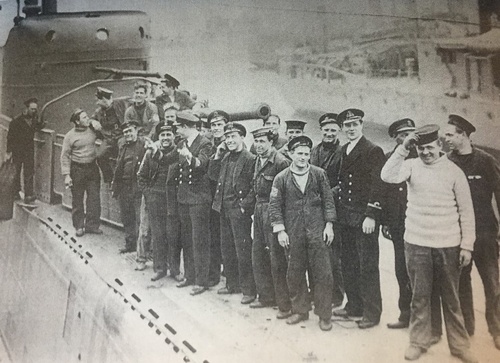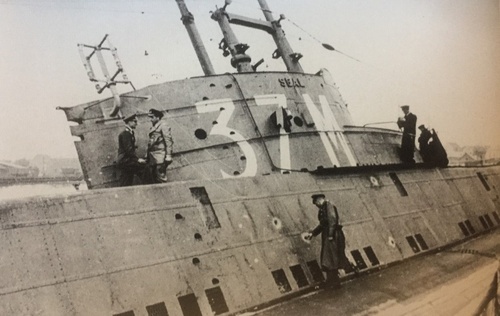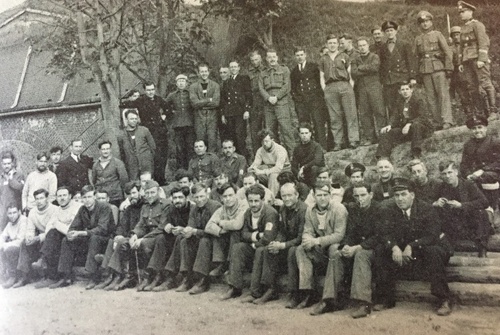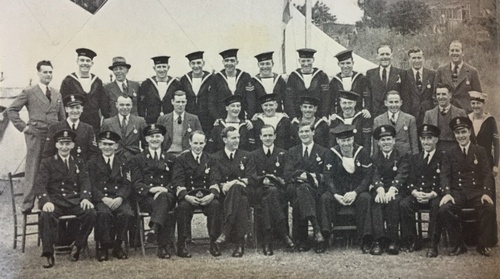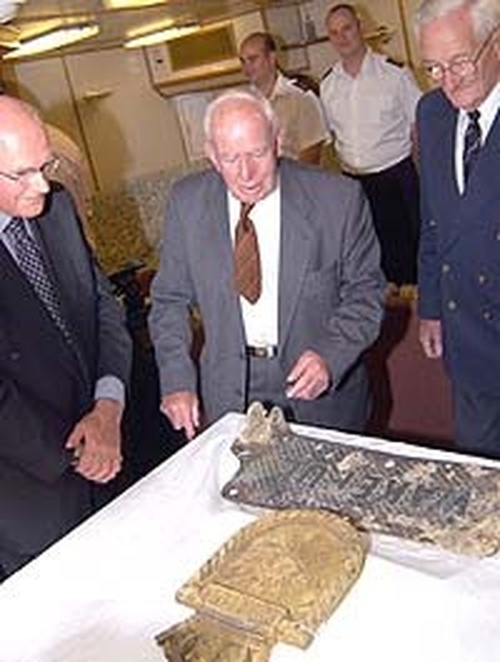Auction: 22003 - Orders, Decorations and Medals
Lot: 385
APRIL 1940: THE 'SILENT SERVICE' OFF NORWAY
'It was on a difficult and dangerous minelaying mission in the Kattegat that H.M. Submarine Seal was involved in one of the strangest, most frightening, and in its own way, most heroically stirring adventures of the Second World War … Under the command of Lieutenant-Commander Rupert Lonsdale, the 1520-ton Seal neared her target area to find German trawlers sweeping the shallow channel through which she must pass. Eventually, having laid her mines, Seal took refuge on the bottom, with all machinery stopped. On the way down she became entangled with a floating mine, which exploded, damaging her hull, flooding several compartments, and burying her stern in the mud.
There was nothing for it but to await darkness before surfacing and making a run for it … With the air becoming increasingly foul every minute - and with all hope of escape virtually gone - Lonsdale called on the crew to join him in prayer. From that moment the story of Seal and her sixty trapped men developed in a manner which has no parallel in naval submarine history … '
Will Not We Fear, by C. E. T. Warren and James Benson, refers.
An outstanding Second World War submariner's group of four awarded to Electrical Artificer 1st Class H. T. 'Johnno' Johnson, Royal Navy
The story of H.M. submarine Seal does indeed have no parallel for she was the Royal Navy's only ship to surrender to the enemy in the entire war. Yet her crew, who displayed extraordinary stoicism in the face of great adversity, really had no other choice, a contention that found support at a post-war Court Martial
With death seemingly imminent, as carbon monoxide poisoning set in, Johnson used up his depleted reserves of strength by changing into his Number One uniform and hoisting himself into his bunk: the last thing he wanted to do was meet his Maker in his oily engine room attire
Subsequently, as a prisoner of war, Johnson teamed-up with his shipmate "Tubby" Lister - and "Wally" Hammond of the Shark - to make a bid for freedom via a tunnel from Marlag at Sandbostel in September 1941, but his freedom was short-lived. Lister, however, managed to remain at large for week and, with Hammond, was eventually dispatched to Colditz. As "Mickey" Rourke of the Seal later put it:
'After "Tubby" Lister and his pal Johnson got caught there was hell to pay, but we didn't mind, as we knew we were doing our little bit to keep Jerry occupied'
1939-45 Star; Atlantic Star; War Medal 1939-45; Royal Navy L.S. & G.C., G.V.R., 3rd issue, coinage head (M. 36487 H. T. Johnson, E.A. 1, H.M.S. Pembroke.), the last slightly polished, generally very fine and better (4)
Henry Thomas Johnson was born in Sheerness, Kent on 4 May 1900 and entered the Royal Navy as an Electrical Artificer 4th Class in May 1921.
Advanced to Electrical Artificer 1st Class in May 1933, and awarded his L.S. & G.C. Medal May 1936, he qualified as a submariner in the same period and was serving in H.M. submarine Seal on the outbreak of hostilities in September 1939.
Loss of the "Seal"
In April 1940, and having already completed 10 wartime patrols, Seal was assigned to Operation "DF-7", a minelaying mission in the Kattegat between Denmark and Sweden. It was a daunting task for a submarine the size of Seal but an attempt by her flotilla C.O. to persuade the redoubtable Max Horton to reconsider his order ended in failure.
And thus she departed Immingham on the 20th, laden with 50 mines, but in carrying out her mission in the Kattegat on 4 May, she ran into trouble, being spotted by a Heinkel He 115 which damaged her with a bomb. Her C.O., Lieutenant-Commander Rupert Lonsdale took Seal down to 90 feet, but her reported position subsequently attracted a force of enemy anti-submarine trawlers. Nonetheless, Seal managed to divert to a secondary target area to release her final batch of mines.
Turning for home and using Asdic to identify the whereabouts of the enemy trawlers, Lonsdale was hopeful of getting away, but those hopes were quickly dashed by the arrival of nine enemy anti-submarine motor torpedo boats. With too many hours of daylight left and because of her size and the shallow nature of the Kattegat, Seal was unable to go deep and or run for it. Then at 1800 hours disaster struck, when she unwittingly entered an enemy minefield: one of her hydroplanes caught a mine stay-cable and the attached mine was swept onto Seal's stern by the current and detonated with a huge explosion.
Johnson and his shipmates were catapulted around Seal's interior as she tilted bow upwards at 10 degrees with a sharp increase in air pressure, the latter indicating serious damage and a large influx of water. But in the ensuing chaos all of her watertight doors were secured and two members of crew rescued from the after end. To everyone's surprise, the pursuing enemy flotilla failed to notice the explosion and appeared to move away, but Lonsdale still had to wait for darkness before attempting to right the stricken Seal and surface.
At about 1030 hours the ballast tanks were blown empty and the main motors started but Seal's stern remained firmly stuck on the seabed. With deteriorating air quality, Lonsdale decided to ditch the submarine's 11-ton drop keel, a move that meant Seal would not be able to submerge again but might just enable her to reach the surface. However, this and a third attempt failed to shift the submarine from her watery grave.
Matters were now desperate in the extreme, the crew beginning to succumb to carbon-monoxide poisoning and Lonsdale, a devout Christian, called upon them to join him in the Lord's Prayer. Then in one final Herculean attempt to shift Seal, he called upon his men to move forward to try and tip the submarine's balance, not a few of them fainting or collapsing in the process. An engineer also found a small pocket of air pressure some way up the companionway and managed to reach and open the valve and, at length, the Seal finally surfaced at 0130 hours; her motors caught fire in the process but due to the lack of oxygen the flames died out.
Once the air pressure was released, the crew suffered blinding headaches, including Lonsdale who clambered out onto the bridge. He decided to make for neutral waters and sent a message to the Admiralty: 'Am making for Swedish coast' but owing to the necessary destruction of his cypher and confidential books, he did not receive two supportive replies: 'Understood and agreed with. Best of luck', followed by 'Safety of personnel would be your first consideration after the destruction of the Asdics'.
To add to Seal's tribulations, her rudder was damaged and she became impossible to steer, instead having to resort to making slow progress in reverse. Then her one remaining engine seized, leaving her a sitting duck on the surface. At 0230 hours a Heinkel and a brace of Arado Ar 196 seaplanes appeared on the scene, Seal's Lewis guns jamming as they came in for the attack. Unable to dive or move, with no remaining defences, Lonsdale had no choice but to surrender, a white messroom table-cloth being hoisted on her mast. The two enemy seaplanes then landed alongside, one of them ordering Seal's captain to swim out to it, an unwelcome exercise duly undertaken by an exhausted Londsale. It was his 35th birthday. The other seaplane embarked his senior Petty Officer. Finally, at about 0630 hours, the enemy anti-submarine trawler UJ-128 hove into view and embarked the reminder of Seal's crew. Although Seal was holed and listing, her crew made efforts to scuttle her prior to crossing to the UJ-128. But much to their surprise, she remained defiant and was towed back to Frederikshaven.
Seal was then towed to Kiel for a proper overhaul, prior to being commissioned into the Kriegsmarine in the spring of 1941 and used as a propaganda exhibit and training boat. She finally met her end in May 1945, when she was scuttled in Heikendorf Bay.
The full story of Seal and her gallant crew has been related in two publications, Will Not We Fear, by C. E. T. Warren and J. Benson and Fatal Ascent - H.M.S. Seal 1940, by Kate Wiggins, in which Electrical Artificer Henry 'Johnno' Johnson emerges as a prominent member of crew; copies of both books are included.
In the bag
He and his shipmates were initially interned at Fort 13, Thorn, prior to being removed to Sandbostel XB in February 1941. Then in June 1942, most of Seal's Petty Officers and ratings were transferred to Marlag und Milag, where - 'home runs' aside - they stayed until April 1945.
A reference to Johnson making his bid for freedom is to be found in Will Not We Fear:
'Seal had had an unusually good team of artificers - any submarine worth her salt will tell you this of herself, but a reasonable objective appraisal would suggest Seal's probably really were above average. And among her artificers one of the most striking characters was "Tubby" Lister.
From them first moment of his captivity he set his heart on escaping and, while his basic philosophy told him the sooner the better, he had enough prudence to know that he needed a certain command of the German language. From Kiel, through Thorn, and into the early days at Sandbostel, he applied himself diligently and surprised himself with the progress that he made. Among his fellow E.R.A.s he discovered two kindred spirits, Johnson of the Seal and "Wally" Hammond of the other submarine, Shark. Together the three of them played their part in the digging of the long Marlag tunnel and together they escaped, alongside eleven others.
For a few hours the three E.R.A.s kept company. Then Johnson got detached, and a day later Hammond and Lister split up. During his seven days of freedom Lister made no great mileage, but he did succeed in entering Hamburg, only to be captured there … it was not very long after this episode that Lister's and Hammond's persistent devotion to the cause of escaping earned them the very great honour of being appointed to Colditz.'
Postscript
Johnson was finally liberated at Oflag XC at Lubeck in May 1945. But he chose not to record the above cited escape attempt in completing his P.O.W. questionnaire, instead filling in the form with a succession of straight 'Yes' or 'No' answers. Like many others who completed the same questionnaire, he was keen to move on and get home.
No doubt Rupert Lonsdale was equally keen to do likewise but as Seal's captain he first had to face a Court Martial for the loss of his command. In the event, he was honourably acquitted and awarded a mention in despatches.
Johnson, meanwhile, resumed his naval career and was finally pensioned ashore in November 1956.
Subject to 20% VAT on Buyer’s Premium. For more information please view Terms and Conditions for Buyers.
Sold for
£420
Starting price
£350


